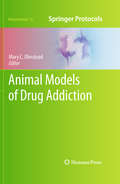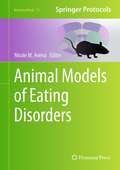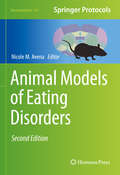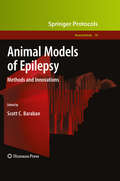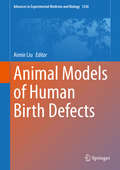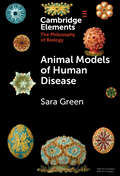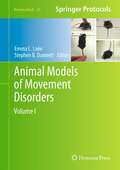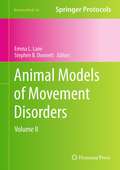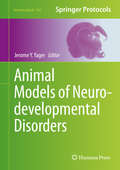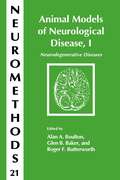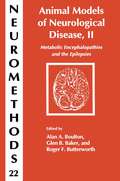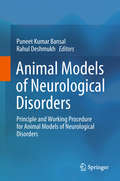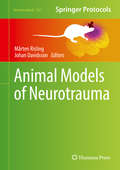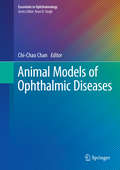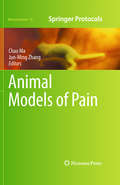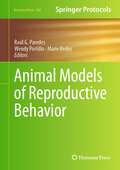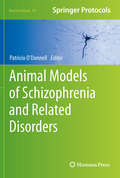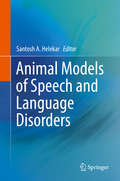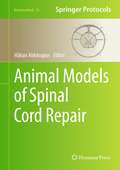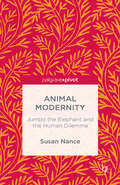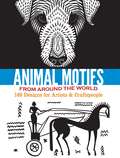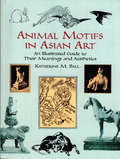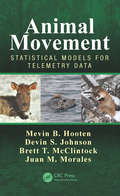- Table View
- List View
Animal Models of Drug Addiction (Neuromethods #53)
by Mary C. OlmsteadOur understanding of addiction and how it is treated has advanced remarkably over the past decades, and much of the progress is related directly to animal research. This is true for both the behavioural aspects of drug use as well as the biological underpinnings of the disorder. In Animal Models of Drug Addiction, experts in the field provide an up-to-date review of complex behavioural paradigms that model different stages of this disorder and explain how each test is used to effectively replicate the progression of drug addiction. This detailed and practical book begins with the most common laboratory measures of addiction in animals, including intracranial self-stimulation (ICSS), drug self-administration, place conditioning, and sensitization. Later chapters describe how these paradigms are used to model the progression of drug addiction, providing insight into the clinical symptomatology of addiction from acquisition of drug use through compulsive drug taking to withdrawal and relapse. Written for the popular Neuromethods series, the contributions offer both methodological detail and a theoretical perspective, appealing to readers familiar with preclinical research on drug addiction as well as those who are newcomers to the field. Cutting-edge and authoritative, Animal Models of Drug Addiction will serve as a basis for future vital research that links the bench to the bedside in the crucial treatment of drug addiction.
Animal Models of Eating Disorders (Neuromethods #74)
by Nicole M. AvenaThe growth of the field of eating disorder research has led to a vast array of empirical articles, and the development of new animal models that can be used to study these disorders continues to stimulate new research. Animal Models of Eating Disorders serves as a collection of detailed techniques contributed by experts in the field who are well-versed in the development and implementation of these models. Since eating disorders are complex and likely due to a combination of environmental, genetic, and social causes, the detailed chapters of this volume have been designed to highlight different contributing factors. Collectively, these chapters give a comprehensive and representative overview of both recently developed and classic methodologies used in the study of eating disorders. Written for the popular Neuromethods series, this work contains the kind of thorough description and implementation advice that promises successful results. Authoritative and practical, Animal Models of Eating Disorders aims to aid researchers in the use of animal models to assist in their investigation and characterization of the behaviors and neurochemical alterations associated with these devastating disorders.
Animal Models of Eating Disorders (Neuromethods #161)
by Nicole M. AvenaThis second edition volume expands on the previous edition with discussions on the latest techniques and animal models used to study eating disorders, and the characterizations of behaviors and neurochemical alterations associated with them. Chapters in this book cover different contributing factors of eating disorders and explore topics such as highlight processed food and binge eating; predicting and classifying rates prone to overeating fat; artificial sweeteners in animal models of binge eating; clinical and preclinical bariatric surgery approaches to studying obesity; anorexia and undereating; and food-anticipatory activity in rat models and its underlying mechanisms. In the Neuromethods series style, chapters include the kind of detail and key advice from the specialists needed to get successful results in your laboratory. Cutting-edge and practical, Animal Models of Eating Disorders, Second Edition is a valuable resource for any researchers interested in learning more about this important and developing field.
Animal Models of Epilepsy: Methods and Innovations (Neuromethods #40)
by Scott C. BarabanWith its complex anatomical, molecular, electrophysiological and behavioral components, epilepsy provides the neuroscientist with nearly boundless opportunities to examine basic neurobiological mechanisms. In Animal Models of Epilepsy: Methods and Innovations, prominent investigators in the field examine several novel models of epilepsy in mice as well as in genetically tractable "simple" species such as Drosophila melanogaster (fruit flies), Caenorhabditis elegans (worms), Xenopus laevis (tadpoles) and Danio rerio (zebrafish). While covering some traditional models, the volume also explores the newest innovations like modeling seizure activity in silica and advanced strategies for seizure detection and gene therapy. As a volume in the successful NeuromethodsTM series, the chapters provide clear, step-by-step protocols and thought-provoking reviews of the most recent advancements in the field. Comprehensive and cutting-edge, Animal Models of Epilepsy: Methods and Innovations is an ideal guide for scientists who wish to expand our understanding of the pathogenesis of this neurological disorder.
Animal Models of Human Birth Defects (Advances In Experimental Medicine And Biology Series #1236)
by Aimin LiuThis book focuses on the use of animal models to study various human defects. It summarizes our current understanding of a variety of common human birth defects and the essential role of animal models in shedding light on the underlying mechanisms of these disorders. Birth defects are the leading cause of infant deaths, and cost billions of dollars in care for those affected. Unfortunately, the lack of a clear understanding of the mechanisms leading to many of these developmental disorders has hindered effective prevention and early intervention strategies. Studies using animal models have provided essential insights into several human birth defects. This book serves as a valuable reference resource for researchers and graduate students who are interested in learning the basic principles as well as the latest advances in the study of the mechanisms of human birth defects.
Animal Models of Human Birth Defects (Advances in Experimental Medicine and Biology #1236)
by Aimin LiuThis book focuses on the use of animal models to study various human defects. It summarizes our current understanding of a variety of common human birth defects and the essential role of animal models in shedding light on the underlying mechanisms of these disorders. Birth defects are the leading cause of infant deaths, and cost billions of dollars in care for those affected. Unfortunately, the lack of a clear understanding of the mechanisms leading to many of these developmental disorders has hindered effective prevention and early intervention strategies. Studies using animal models have provided essential insights into several human birth defects. This book serves as a valuable reference resource for researchers and graduate students who are interested in learning the basic principles as well as the latest advances in the study of the mechanisms of human birth defects.
Animal Models of Human Disease (Elements in the Philosophy of Biology)
by null Sara GreenThe crucial role of animal models in biomedical research calls for philosophical investigation of how and whether knowledge about human diseases can be gained by studying other species. This Element delves into the selection and construction of animal models to serve as preclinical substitutes for human patients. It explores the multifaceted roles animal models fulfil in translational research and how the boundaries between humans and animals are negotiated in this process. The book also covers persistent translational challenges that have sparked debates across scientific, philosophical, and public arenas regarding the limitations and future of animal models. Among the are persistent tensions between standardization and variation in medicine, as well as between strategies aiming to reduce and recapitulate biological complexity. Finally, the book examines the prospects of replacing animal models with animal-free methods. The Element demonstrates why animal modeling should be of interest to philosophers, social scientists, and scientists alike.
Animal Models of Movement Disorders, Volume I: Volume I (Neuromethods #61)
by Stephen B. Dunnett Emma L. LaneMovement is the way that animals interact with their environment and is under the organization and complex control of the brain and spinal cord. Multiple central nervous systems, including cortex, basal ganglia, cerebellum, and brainstem, interact to provide precise motor control and integration. Damage or disease within these systems cause profound motor disturbances in man, which can be effectively modeled in animals to develop a better understanding and treatment of the human condition. Animal Models of Movement Disorders introduces a variety of methods and techniques used to model and assess motor function in experimental animals from lower orders, such as drosophila and c. elegans, through vertebrate species including fish, to mammals, such as rodents and non-human primates. The most advanced contemporary models in each system are presented at multiple levels of analysis from molecular and genetic modeling, lesions, anatomy, neurochemistry, to imaging and behavior. Volume I contains general methods of movement disorder assessment as well as an extensive section on dopamine systems. <P><P> Comprehensive and meticulous, Animal Models of Movement Disorders serves as a valuable reference for those studying motor disorders by covering methodologies in detail and providing the information necessary to consider both the appropriate models and assessment tools that can most informatively answer the key experimental issues in the field.
Animal Models of Movement Disorders, Volume II: Volume II (Neuromethods #62)
by Stephen B. Dunnett Emma L. LaneMovement is the way that animals interact with their environment and is under the organization and complex control of the brain and spinal cord. Multiple central nervous systems, including cortex, basal ganglia, cerebellum, and brainstem, interact to provide precise motor control and integration. Damage or disease within these systems cause profound motor disturbances in man, which can be effectively modeled in animals to develop a better understanding and treatment of the human condition. Animal Models of Movement Disorders introduces a variety of methods and techniques used to model and assess motor function in experimental animals from lower orders, such as drosophila and c. elegans, through vertebrate species including fish, to mammals, such as rodents and non-human primates. The most advanced contemporary models in each system are presented at multiple levels of analysis from molecular and genetic modeling, lesions, anatomy, neurochemistry, to imaging and behavior. Volume II of this detailed collection contains sections on the basal ganglia, neo- and allo-cortical systems, cerebellar and brain stem systems, as well as spinal cord systems.<P><P> Comprehensive and meticulous, Animal Models of Movement Disorders serves as a valuable reference for those studying motor disorders by covering methodologies in detail and providing the information necessary to consider both the appropriate models and assessment tools that can most informatively answer the key experimental issues in the field.
Animal Models of Neurodevelopmental Disorders (Neuromethods #104)
by Jerome Y. YagerProviding a spectrum of models that is reflective of the various species that can be utilized in experimentation on disorders across a broad range of developmental disabilities, this volume collects expert contributions involved in investigation of the causes, outcomes, treatment, and prevention. Animal Models of Neurodevelopmental Disorders explores models of perinatal hypoxia-ischemia/cerebral palsy and stroke, autism spectrum disorder, fetal alcohol syndrome, as well as mental retardation. Written in the popular Neuromethods series style, chapters include the kind of detail and key advice from the specialists needed to get successful results in your own laboratory. Practical and authoritative, Animal Models of Neurodevelopmental Disorders serves to introduce and entice those interested in better understanding and treating these disorders to the vital animal model world of investigation.
Animal Models of Neurological Disease, I: Neurodegenerative Diseases (Neuromethods #21)
by Alan A. Boulton Glen B. Baker Roger F. ButterworthThis and several other volumes in the Neuromethods series will describe a number of animal models of neu- psychiatric disorders. Because of increasing public concern over the ethical treatment of animals in research, we felt it incumbent upon us to include this general preface to these volumes in order to indicate why we think further research using animals is necessary and why animal models of psychi- ric and neurologic disorders, in particular, are so important. We recognize that animals should only be used when suitable alternatives are not available. We think it self-e- dent, however, that humans can only be experimented upon in severely proscribed circumstances and alternative pro- dures using cell or tissue culture are inadequate in any models requiring assessments of behavioral change or of complex in vivo processes. However, when the distress, discomfort, or pain to the animals outweighs the anticipated gains for human welfare, then the research is not ethical and should not be carried out.
Animal Models of Neurological Disease, II: Metabolic Encephalopathies and Epilepsies (Neuromethods #22)
by Alan A. Boulton Glen B. Baker Roger F. ButterworthThe use of animal models continues to be the most reliable way of studying pathophysiologic mechanisms as well as treatments for neurological disorders. In two companion volumes, Animal Models of Neurological Disease highlights new information and techniques available in this rapidly growing area.<P><P> This volume of Neuromethods-the second of a two-volume set on Animal Models of Neurological Disease-presents forefront techniques for studying a variety of seizure disorders and metabolic diseases affecting the CNS. Contributions have been gleaned from a panel of experts in several areas, including: human stroke * focal and global ischemia * brain hypoxia in vivo and in vitro * Wernicke-Korsakoff syndrome * chemically induced and genetic-based seizures * the kindling model of epilepsy * hepatic encephalopathies * vitamin deficiency syndromes * hereditary hyperammonemias. <P><P> Boulton, Baker, and Butterworth's important new set on Animal Models of Neurological Disease is an outstanding guide for all researchers striving to better understand neurological disease.
Animal Models of Neurological Disorders: Principle and Working Procedure for Animal Models of Neurological Disorders
by Puneet Kumar Bansal Rahul DeshmukhThis book introduces undergraduate, postgraduate and research students and scientists to animal models of neurological disorders, along with their working principle and brief procedures. Addressing all the disorders related to the central nervous system (CNS) in a single platform, on the basis of various literature surveys it describes different procedures to induce a single disease with the help of toxins/chemicals. It also includes numerous protocols for inducing single neurological diseases, thus fulfilling an urgent need for a book that makes specific procedures for neurological disorders available, so that specific disease can be induced in laboratories according to the availability of resources. Further, it acquaints readers with the pathological changes that occur in a particular neurological disorder, which reflect specific signs and symptoms of any particular disease, and examines how they affect everyday life. It is a valuable resource for researchers aiming to eradicate or improve neurological disorders by testing the benefits of different drugs.
Animal Models of Neurotrauma (Neuromethods #149)
by Mårten Risling Johan DavidssonThis volume looks into the need for a variety of experimental models for research on traumatic brain injury (TBI) and peripheral nervous system. It also describes a number of experimental models, such as mechanical devices, that have been developed to model neurotrauma in animal experiments. The overall aim of this book is to explore the variety of models and how they are used in current research. The chapters in this book are organized in four sections and talk about animal models for TBI; animal models for spinal cord or nerve injury; and translational aspects, secondary injuries, in vitro studies, and evaluation of large data sets. In Neuromethods series style, chapters include the kind of detail and key advice from the specialists needed to get successful results in your laboratory.Cutting-edge and comprehensive, Animal Models of Neurotrauma is a valuable resource for researchers interested in expanding their knowledge and research in this developing field.
Animal Models of Ophthalmic Diseases (Essentials in Ophthalmology)
by Chi-Chao ChanThis book describes experimental animal models that mimic common human ocular diseases: herpetic keratitis, cataract, glaucoma, age-related macular degeneration, diabetic retinopathy, uveitis, retinitis pigmentosa, Graves' disease, and intraocular tumors. In conjunction, these models reflect the diversity and utility of tools used to study human disease. World expert clinicians discuss each model based on their clinical experience and the text is supported by numerous photos and diagrams. In describing the most pertinent animal models of ophthalmic diseases, this book will be of interest to ophthalmologists, vision researchers, fellows, residents and medical students.
Animal Models of Pain (Neuromethods #49)
by Jun-Ming Zhang Chao MaWith the loss of work days, the price of health care and payments for compensation, litigation, and malpractice, and the overwhelming cost of human suffering, chronic pain syndromes affect humanity enormously on both an economic and personal level. In Animal Models of Pain, expert investigators in the field provide a consolidated review of the current state of pain research by capturing the diversity of animal models that are used to investigate pain mechanisms, which range from surgical incision to mechanical compression and from spinal cord injury to cutaneous/local inflammation and beyond. As a volume in the respected Neuromethods series, this book delivers its vital content through detailed descriptions of a wide variety of step-by-step laboratory methods. Authoritative and cutting-edge, Animal Models of Pain seeks to lead scientists closer to the ultimate goal of improving the quality of life and relieving the unbearable burden of chronic pain for millions of people throughout the world.
Animal Models of Reproductive Behavior (Neuromethods #200)
by Raúl G. Paredes Wendy Portillo Marie BedosThis volume presents the latest techniques to study several aspects of reproductive behavior in different species. The chapters in this book cover topics such as methods to investigate social behavior; sexual motivation and reward, both of which are fundamental for the initiation of sexual behavior; olfactory signaling; different characteristics and models of reproductive function; and parental behavior in both rats and rabbits. In the Neuromethods series style, chapters include the kind of detail and key advice from the specialists needed to get successful results in your laboratory. Cutting-edge and practical, Animal Models of Reproductive Behavior is a valuable resource for both experienced researchers and students who want to incorporate new techniques into their studies of reproductive behavior.
Animal Models of Schizophrenia and Related Disorders (Neuromethods #59)
by Patricio O'DonnellAnimal models of schizophrenia and other major psychiatric disorders have been sought for decades, and, as a result, we are now facing new vistas on pathophysiology that could lead to novel therapeutic approaches and even hint at possible preventive strategies. Animal Models of Schizophrenia and Related Disorders presents an overview of the information that can be obtained with several different models and a detailed account of how to generate such models in order to ensure that the manipulations used to model schizophrenia-relevant phenomena are used consistently across laboratories. This detailed volume features pharmacological models such as non-competing NMDA antagonists, emphasizing their use in vitro, neurodevelopmental models such as the neonatal ventral hippocampal lesion and the antimitotic MAM, models that reproduce environmental factors such as neonatal hypoxia, vitamin D deficits, and prenatal immune activation, as well as several different genetic model approaches. As a volume in the Neuromethods series, this volume contains the kind of detailed description and implementation advice that is crucial for getting optimal results. Practical and cutting-edge, Animal Models of Schizophrenia and Related Disorders highlights the successes in the use of animal models to gain insight on pathophysiological mechanisms of relevance to major psychiatric disorders in the hope of inspiring investigators to expand the research and test targets that could restore or ameliorate function.
Animal Models of Speech and Language Disorders
by Santosh A. HelekarBasic research over the last decade or two has uncovered similarities between speech, especially its sensori-motor aspects, and vocal communication in several non-human species. The most comprehensive studies so far have been conducted in songbirds. Songbirds offer us a model system to study the interactions between developmental or genetic predispositions and tutor-dependent influences, on the learning of vocal communication. Songbird research has elucidated cellular and molecular mechanisms underlying learning and production of vocal patterns, perception of vocal sounds, vocal motor control and vocal neuromotor plasticity. More recently, the entire genome of the songbird zebra finch has been sequenced. These discoveries, along with the identification of several genes implicated in familial human speech and language disorders, have made it possible to look for analogues of speech and language dysfunction in zebra finches, at least at the perceptual and sensori-motor levels. Two approaches in particular have led us closer to the development of animal models of human speech conditions, namely developmental stuttering and a familial verbal dyspraxia associated with a mutation in the gene for the transcription factor FoxP2. Work on other animals that show developmental sensori-motor learning of vocal sounds used for communication have also shown significant progress, leading to the possibility of development of models of speech and language dysfunction in them. Among mammals, the principal ones include dolphins and whales. In non-human primates, while vocal learning per se is not very prominent, investigations on their communicative abilities have thrown some light on the rudiments of language. These considerations make the publication of a book focused on animal models of speech and language disorders, detailing the overall investigative approach of neurobehavioral studies in animals capable of vocal communication and learned vocalizations, a much-needed and worthwhile project. It would serve as a unifying review of research in this new multidisciplinary frontier, spanning the molecular to the behavioral, for clinicians and researchers, as well as a teaching resource for advanced speech pathology and neuroscience students. This book will also be the first of its kind.
Animal Models of Spinal Cord Repair (Neuromethods #76)
by Håkan AldskogiusThe development of treatment strategies that can help patients with spinal cord injury to regain lost functions and an improved quality of life is a major medical challenge, and experimental spinal cord research has to meet these challenges by resolving fundamental problems, establishing a basis for possible novel treatment strategies of spinal cord injury, and motivating their clinical translation. In Animal Models of Spinal Cord Repair, expert researchers examine a broad range of experimental models for research on spinal cord injury, how they have contributed to our current state of knowledge, and what their advantages are in the further advancement of spinal cord repair. With models from simple lamprey to non-human primates, the information presented is intended to guide the implementation of animal models for spinal cord repair as well as to raise the awareness of the relevance of experimental models which may not be in the current mainstream of this research. As a part of the Neuromethods series, this work contains the kind of detailed description and implementation advice to guarantee successful results in the laboratory. Comprehensive and cutting-edge, Animal Models of Spinal Cord Repair presents the background information and hands-on methods descriptions, as well as the basic and clinical issues, needed to stimulate and guide researchers with different backgrounds towards the development of improved strategies for functionally relevant repair of the injured human spinal cord.
Animal Modernity: Jumbo The Elephant And The Human Dilemma
by Susan NanceThe concept of 'modernity' is central to many disciplines, but what is modernity to animals? Susan Nance answers this question through a radical reinterpretation of the life of Jumbo the elephant. In the 1880s, consumers, the media, zoos, circuses and taxidermists, and (unknowingly) Jumbo himself, transformed the elephant from an orphan of the global ivory trade and zoo captive into a distracting international celebrity. Citizens on two continents imaged Jumbo as a sentient individual and pet, but were aghast when he died in an industrial accident and his remains were absorbed by the taxidermic and animal rendering industries reserved for anonymous animals. The case of Jumbo exposed the 'human dilemma' of modern living, wherein people celebrated individual animals to cope or distract themselves from the wholesale slaughter of animals required by modern consumerism.
Animal Monsters: The Truth About Scary Creatures
by Laurence PringleDragons, giants, sea serpents--these are the monsters of yesteryear, but they lived only in the imagination. People today still like to create monsters, but everyone knows they aren't real. Or are they? There are scary creatures in the world that may seem like monsters, and they can be very dangerous. But many "monsters" are less exciting and harmful than people would believe. The truth about these creatures-and some that live only in the human imagination--is in this book!
Animal Motifs from Around the World: 140 Designs for Artists & Craftspeople
by Doris RosenthalDrawn from the ancient art and artifacts of an international array of museum collections, this spectacular volume offers a unique selection of unusual animal motifs from Prussia, Egypt, Persia, China, Germany, Sweden, and other areas. The edgy designs possess a timeless appeal that makes them especially attractive to contemporary designers, tattoo artists, crafters, and others.
Animal Motifs in Asian Art: An Illustrated Guide to Their Meanings and Aesthetics
by Katherine M. BallAuthoritative reference deals primarily with animal symbolism in Japanese art, with occasional mention of the decorative art of China, India, and Persia. Arranged in the format of a dictionary, the explanatory text is rich with sidelights from literature and legend, while 673 black-and-white illustrations depict dragons, tigers, bats, and other creatures with symbolic significance.
Animal Movement: Statistical Models for Telemetry Data
by Mevin B. Hooten Devin S. Johnson Brett T. McClintock Juan M. MoralesThe study of animal movement has always been a key element in ecological science, because it is inherently linked to critical processes that scale from individuals to populations and communities to ecosystems. Rapid improvements in biotelemetry data collection and processing technology have given rise to a variety of statistical methods for characterizing animal movement. The book serves as a comprehensive reference for the types of statistical models used to study individual-based animal movement. Animal Movement is an essential reference for wildlife biologists, quantitative ecologists, and statisticians who seek a deeper understanding of modern animal movement models. A wide variety of modeling approaches are reconciled in the book using a consistent notation. Models are organized into groups based on how they treat the underlying spatio-temporal process of movement. Connections among approaches are highlighted to allow the reader to form a broader view of animal movement analysis and its associations with traditional spatial and temporal statistical modeling. After an initial overview examining the role that animal movement plays in ecology, a primer on spatial and temporal statistics provides a solid foundation for the remainder of the book. Each subsequent chapter outlines a fundamental type of statistical model utilized in the contemporary analysis of telemetry data for animal movement inference. Descriptions begin with basic traditional forms and sequentially build up to general classes of models in each category. Important background and technical details for each class of model are provided, including spatial point process models, discrete-time dynamic models, and continuous-time stochastic process models. The book also covers the essential elements for how to accommodate multiple sources of uncertainty, such as location error and latent behavior states. In addition to thorough descriptions of animal movement models, differences and connections are also emphasized to provide a broader perspective of approaches.
